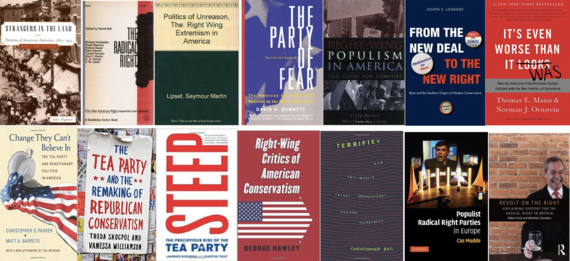I recently criticized US political science for being blind of the right eye, arguing that scholars of American politics have been ill-prepared for three of the main political developments in American politics this century: the role of neoconservatives in the George W. Bush administration, the rise of the Tea Party, and the current success of Donald Trump. I argued that the reasons for this blond spot are of a structural nature, affecting the study of American politics even more than other parts of the discipline.
I ended the post with a promise to provide a list of the limited scholarship that could help provide a better understanding of the rise of Donald Trump and Trumpism, i.e. his unique form of radical right politics. I don't claim to include all relevant resources; most notably, I focus exclusively on books (referencing the original and most recent and updated version). Few of these studies have been written by political scientists, let alone by mainstream political scientists, but perhaps the phenomenal public attention paid to Trump will change that.
As I have argued in several other posts, nativism and radical right politics have a long history in the United States. The classic study to understand the long tradition of American nativism is historian John Higham's seminal Strangers in the Land: Patterns of American Nativism, 1860-1925 (1955/2002), which covers the period of the Know Nothings to the second coming of the Ku Klux Klan. The classic study of the postwar radical right is sociologist Daniel Bell's edited volume The Radical Right: The New American Right (1963/2001), which focuses particularly on the anti-communist radical right of the 1950s, which the progressive historian Richard Hofstadter famously referred to as "the paranoid style in American politics."
There are three books that focus on the whole period of the mid-19th century to the late-20th century. Sociologists Seymour Martin Lipset and Earl Raab's The Politics of Unreason: Right Wing Extremism in America, 1790-1977 (1970/1978), discusses the US radical right on the basis of a sociological theory of status politics and working class authoritarianism that is still highly current today. Historian David H. Bennett's The Party of Fear: The American Far Right from Nativism to the Militia (1988/1995) is more a "narrative history," which puts individual groups and movements within their specific historical context. In Right-Wing Populism in America: Too Close for Comfort (2000) political activists Chip Berlet and Matthew N. Lyons, finally, provide the most comprehensive and detailed overview of the US radical right through the conceptual lens of populism and producerism, tying it somewhat to the much more developed literature on the European radical right.
But to understand the rise of Trump and Trumpism we should not only look at the (often fringe) radical right, or what the media have come to misguidedly call "alt right" in recent times, but also on the transformation of the two-party system in general, and the Republican Party in particular. In From the New Deal to the New Right: Race and the Southern Origins of Modern Conservatism (2009) University of Oregon political scientist Joe Lowndes analyzes the conscious strategy within the Grand Old Party (GOP) to use "race" to force a re-alignment in the South, where nativist and racist voters had traditionally supported the so-called Dixiecrats. In many ways the Trump campaign can be seen as the extremist swan song of the Southern Strategy of the GOP. The bestseller It's Even Worse Than It Looks: How the American Constitutional System Collided With the New Politics of Extremism Thomas Mann and Norman Ornstein, provides a useful complementary perspective to Lowndes study, focusing more specifically on the radicalization of the GOP in Congress, clearly showing that the GOP was not "hijacked" by Trump, it created Trump!
Surprisingly, the rise of the Tea Party, just a few years ago, features little in the current debate on Trump. And yet, as the few insightful studies of the Tea Party show, the both phenomena play on very similar attitudes and frustrations. In the most empirical account, Change They Can't Believe In: The Tea Party and Reactionary Politics in America (2013), political scientists Christopher S. Parker (University of Washington) and Matt A. Barreto (UCLA) hark back to the theories of the 1960s and 1970s (e.g. Bell and Lipset) as they interpret the Tea Party primarily as a reactionary response to recent changes in American society, most notably related to majority-minority relations. Harvard University political scientists Theda Skocpol and Vanessa Williamson take a different approach in their The Tea Party: The Remaking of Republican Conservatism (2013), emphasizing the internal struggles within Republican conservatism and the role of the conservative media (notably Fox News). Finally, Steep: The Precipitous Rise of the Tea Party (2012) is a highly original volume edited by Lawrence Rosenthal and Christine Trost, who direct the Center for Right-Wing Studies at the University of California at Berkeley, as far as I know the only research center in the US specifically devoted to right-wing politics (full disclosure: I am affiliated with the Center). Steep is of particular value because it includes scholars from various disciplines adopting different, and sometimes opposing, theoretical perspectives on the character and explanations of the Tea Party.
But the Tea Party is not the only conservative uprising against the Republicans In Name Only (RINO). In a fascinating new book, Right-Wing Critics of American Conservatism, University of Alabama political scientist George Hawley presents an overview of the heterogeneous fauna of right-wing groups and individuals that exist in the shadows of the GOP, from libertarians to white supremacists. In his book Terrified: How Anti-Muslim Fringe Organizations Became Mainstream (2016) Duke University sociologist Christopher A. Bail focuses on a specific subculture that has been instrumental in bridging the mainstream right and the radical right in the US. The importance of Islamophobia to the 2016 presidential campaign of Trump, as well as some other candidates (like Ted Cruz), is difficult to overstate.
Finally, while there are several specific American aspects to the character and rise of Trump and Trumps, they are part of a broader rise in radical right politics in western democracies, most notably in Western Europe. And while the radical right is a fairly marginal topic of study in American politics, it is among the most studied topics in European politics. My own Populist Radical Right Parties in Europe (2007) provides a critical "state of the art" overview of the rich scholarship on radical right parties in Europe, while Revolt on the Right: Explaining for the Radical Right in Britain (2013), by British political scientists Robert Ford and Matthew Goodwin, is an accessible and concise application of the European literature to the British case, specifically the United Kingdom Independence Party (UKIP), perhaps the most familiar to American readers.
This list is not meant to be exhaustive and will undoubtedly miss some other useful resources. If anyone knows additional books that provide solid analysis, rather than political advocacy, on the radical right in the US, please suggest them in the comments.

